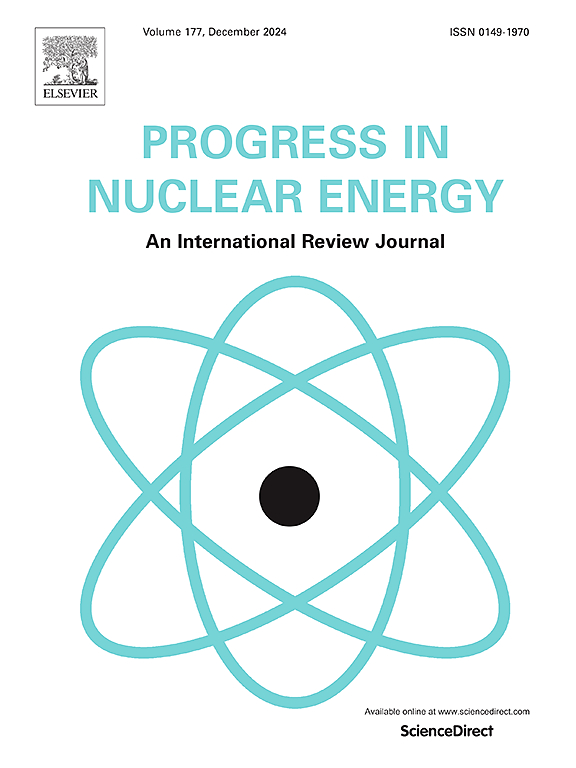Safety margins improvement by means of the passive heat removal system and the HA-2 in VVER-1000/V320 reactors
IF 3.3
3区 工程技术
Q1 NUCLEAR SCIENCE & TECHNOLOGY
引用次数: 0
Abstract
One of the key functions of the safety systems is the removal of decay heat during an accidental sequence. Conventional VVER reactor designs have safety systems capable of removing residual heat in an emergency scenario, but these systems will be challenged to operate under station blackout conditions. As a result, some of the Gen III/Gen III + VVER designs incorporate passive safety systems capable of maintaining the decay heat removal in the event of a total loss of AC power. The present study focuses on the analysis of the air-cooled Passive Heat Removal System (PHRS) incorporated in some Gen III/Gen III + designs such as the VVER-1000/V412, the VVER-1200/V392M, V509, V523 or the VVER-TOI. For this purpose, a PHRS model has been developed in the TRACE system code, which has been incorporated into a model of a VVER-1000/V320 reactor which also includes another Gen III/Gen III + VVER reactors common feature; the Second Stage Hydroaccumulators (HA-2), subsystem of the Emergency Core Cooling System. Subsequently, a Station Blackout (SBO), a SBO along with an SBLOCA and a SBO along with an LBLOCA sequences have been analyzed with the air-cooled PHRS operating. The results show that in some scenarios, the PHRS performance is critical to lead the sequence to a safe state by transporting the decay heat to the atmosphere heat sink for at least 24 h.
通过被动排热系统和HA-2在VVER-1000/V320反应堆中提高安全裕度
安全系统的关键功能之一是在事故序列中去除衰变热。传统的VVER反应堆设计具有能够在紧急情况下去除余热的安全系统,但这些系统将面临在核电站停电条件下运行的挑战。因此,一些第三代/第三代+ VVER设计采用了被动安全系统,能够在交流电源完全丧失的情况下保持衰变热排出。本研究的重点是分析一些第三代/第三代+设计中采用的风冷被动排热系统(PHRS),如VVER-1000/V412、VVER-1200/V392M、V509、V523或VVER-TOI。为此,在TRACE系统代码中开发了一个PHRS模型,该模型已被纳入VVER-1000/V320反应堆的模型,该模型还包括另一个第三代/第三代+ VVER反应堆的共同特征;二级蓄能器(HA-2),应急堆芯冷却系统的子系统。随后,在风冷式PHRS运行的情况下,对Station Blackout (SBO)、SBO + SBLOCA、SBO + LBLOCA序列进行了分析。结果表明,在某些情况下,通过将衰变热传递到大气散热器至少24 h, PHRS性能对于使序列达到安全状态至关重要。
本文章由计算机程序翻译,如有差异,请以英文原文为准。
求助全文
约1分钟内获得全文
求助全文
来源期刊

Progress in Nuclear Energy
工程技术-核科学技术
CiteScore
5.30
自引率
14.80%
发文量
331
审稿时长
3.5 months
期刊介绍:
Progress in Nuclear Energy is an international review journal covering all aspects of nuclear science and engineering. In keeping with the maturity of nuclear power, articles on safety, siting and environmental problems are encouraged, as are those associated with economics and fuel management. However, basic physics and engineering will remain an important aspect of the editorial policy. Articles published are either of a review nature or present new material in more depth. They are aimed at researchers and technically-oriented managers working in the nuclear energy field.
Please note the following:
1) PNE seeks high quality research papers which are medium to long in length. Short research papers should be submitted to the journal Annals in Nuclear Energy.
2) PNE reserves the right to reject papers which are based solely on routine application of computer codes used to produce reactor designs or explain existing reactor phenomena. Such papers, although worthy, are best left as laboratory reports whereas Progress in Nuclear Energy seeks papers of originality, which are archival in nature, in the fields of mathematical and experimental nuclear technology, including fission, fusion (blanket physics, radiation damage), safety, materials aspects, economics, etc.
3) Review papers, which may occasionally be invited, are particularly sought by the journal in these fields.
 求助内容:
求助内容: 应助结果提醒方式:
应助结果提醒方式:


